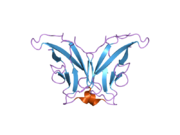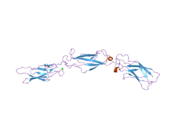CDH8
Cadherin-8 is a protein that in humans is encoded by the CDH8 gene.[5][6][7]
Function
This gene encodes a type II classical cadherin from the cadherin superfamily, integral membrane proteins that mediate calcium-dependent cell-cell adhesion. Mature cadherin proteins are composed of a large N-terminal extracellular domain, a single membrane-spanning domain, and a small, highly conserved C-terminal cytoplasmic domain. The extracellular domain consists of 5 subdomains, each containing a cadherin motif, and appears to determine the specificity of the protein's homophilic cell adhesion activity. Type II (atypical) cadherins are defined based on their lack of a HAV cell adhesion recognition sequence specific to type I cadherins. This particular cadherin is expressed in brain and is putatively involved in synaptic adhesion, axon outgrowth and guidance.[7]
Clinical significance
Disruptions of CDH8 in humans have been implicated in autism.[8][9]
References
- ^ a b c GRCh38: Ensembl release 89: ENSG00000150394 – Ensembl, May 2017
- ^ a b c GRCm38: Ensembl release 89: ENSMUSG00000036510 – Ensembl, May 2017
- ^ "Human PubMed Reference:". National Center for Biotechnology Information, U.S. National Library of Medicine.
- ^ "Mouse PubMed Reference:". National Center for Biotechnology Information, U.S. National Library of Medicine.
- ^ Kremmidiotis G, Baker E, Crawford J, Eyre HJ, Nahmias J, Callen DF (May 1998). "Localization of human cadherin genes to chromosome regions exhibiting cancer-related loss of heterozygosity". Genomics. 49 (3): 467–71. doi:10.1006/geno.1998.5281. PMID 9615235.
- ^ Suzuki S, Sano K, Tanihara H (Apr 1991). "Diversity of the cadherin family: evidence for eight new cadherins in nervous tissue". Cell Regulation. 2 (4): 261–70. doi:10.1091/mbc.2.4.261. PMC 361775. PMID 2059658.
- ^ a b "Entrez Gene: CDH8 cadherin 8, type 2".
- ^ Pagnamenta AT, Khan H, Walker S, Gerrelli D, Wing K, Bonaglia MC, et al. (Jan 2011). "Rare familial 16q21 microdeletions under a linkage peak implicate cadherin 8 (CDH8) in susceptibility to autism and learning disability". Journal of Medical Genetics. 48 (1): 48–54. doi:10.1136/jmg.2010.079426. PMID 20972252.
- ^ Brandler, William M.; Antaki, Danny; Gujral, Madhusudan; Noor, Amina; Rosanio, Gabriel; Chapman, Timothy R.; et al. (2016). "Frequency and Complexity of De Novo Structural Mutation in Autism". The American Journal of Human Genetics. 98 (4): 1–13. doi:10.1016/j.ajhg.2016.02.018.
{{cite journal}}: Unknown parameter|name-list-format=ignored (|name-list-style=suggested) (help)
Further reading
- Tanihara H, Sano K, Heimark RL, St John T, Suzuki S (Apr 1994). "Cloning of five human cadherins clarifies characteristic features of cadherin extracellular domain and provides further evidence for two structurally different types of cadherin". Cell Adhesion and Communication. 2 (1): 15–26. doi:10.3109/15419069409014199. PMID 7982033.
- Kido M, Obata S, Tanihara H, Rochelle JM, Seldin MF, Taketani S, Suzuki ST (Mar 1998). "Molecular properties and chromosomal location of cadherin-8". Genomics. 48 (2): 186–94. doi:10.1006/geno.1997.5152. PMID 9521872.
- Shimoyama Y, Tsujimoto G, Kitajima M, Natori M (Jul 2000). "Identification of three human type-II classic cadherins and frequent heterophilic interactions between different subclasses of type-II classic cadherins". The Biochemical Journal. 349 (Pt 1): 159–67. doi:10.1042/0264-6021:3490159. PMC 1221133. PMID 10861224.
- Blaschke S, Mueller CA, Markovic-Lipkovski J, Puch S, Miosge N, Becker V, Mueller GA, Klein G (Oct 2002). "Expression of cadherin-8 in renal cell carcinoma and fetal kidney". International Journal of Cancer. 101 (4): 327–34. doi:10.1002/ijc.10623. PMID 12209956.
External links
- CDH8 human gene location in the UCSC Genome Browser.
- CDH8 human gene details in the UCSC Genome Browser.








